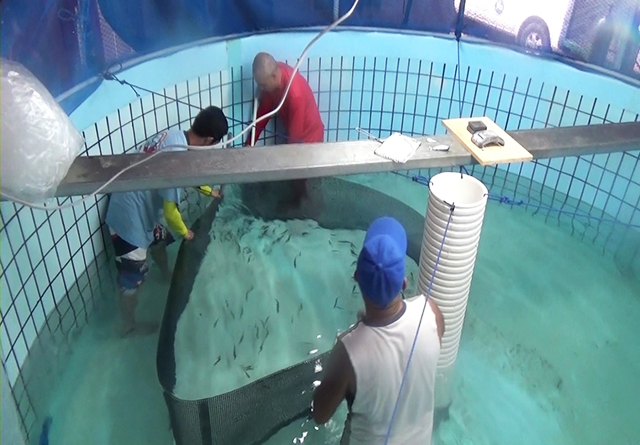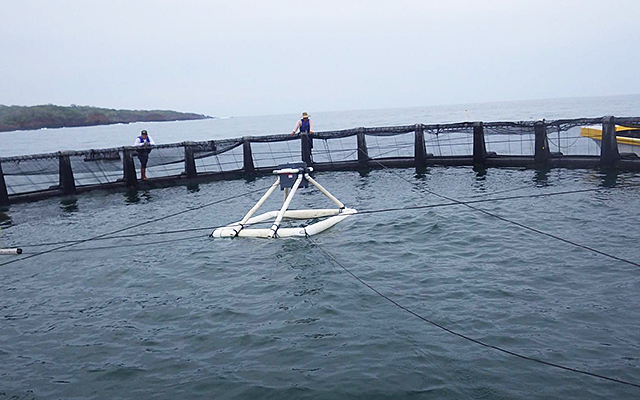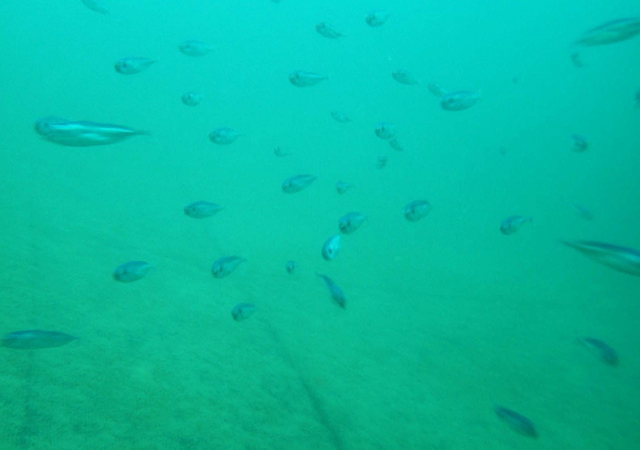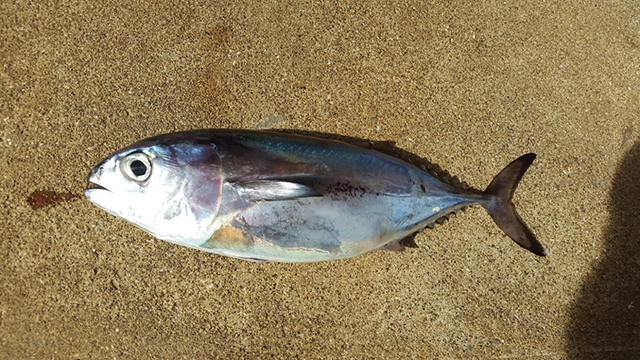Points
- Kindai University achieves results in yellowfin tuna culture research, supported by JST and JICA.
- World’s first successful culture of yellowfin tuna from eggs to young fish.
- Young fish have currently been returned to an on-land tank due to ease of environmental management compared to ocean-surface fish preserve; team aims to achieve complete farm-raising technology in two years.
- It is hoped that applying the scientific knowledge and culture techniques obtained through this research to the forecasting of natural yellowfin tuna resources will, in future, contribute to sustainable fishing in developing countries in located tropical and subtropical regions, as well as island nations. These efforts also highlight to the international community Japan’s commitment to sustainable tuna fishing.
- It is hoped that these findings will lead to the development of new yellowfin tuna farm-fishing industries in developing and island nations (support for developing nations), and form a foundation for Japanese companies to conduct overseas farm-fishing operations in future.
Under the Science and Technology Research Partnership for Sustainable Development (SATREPS)1) program operated cooperatively by Japan Science and Technology Agency (JST) and the Japan International Cooperation Agency (JICA), from June to July the research group led by Dr. Yoshifumi Sawada of Kindai University’s Aquaculture Research Institute successfully transferred yellowfin tuna fingerlings, which had been artificially incubated from eggs and raised in an on-land tank, to an ocean-surface fish preserve. The fingerlings, which have since been re-transferred to an on-land tank after growing to young fish in the ocean environment, will continue to be raised until they reach adulthood.
The successful transfer of tuna fry to an ocean environment represents a major step toward complete farm-raising2) of the species. Particularly significant is the fact that the fingerlings were able to be raised to a practical size (9-13 cm) prior to transfer. The tuna were reared to juvenile stage in an on-land tank, transferred to an ocean surface fish preserve and raised to young stage, and have since been re-transferred to an on-land tank, currently reaching 30 cm in size. Applying the Kindai University techniques that achieved the successful culture of bluefin tuna, to achieve the successful transfer of yellowfin tuna—a species regarded as difficult to raise—represents a significant research accomplishment.
Conducted through joint research with the Autoridad de los Recursos Acuáticos de Panamá (ARAP) and the Inter-American Tropical Tuna Commission (IATTC)3) into the sustainable use of the bluefin and yellowfin tuna species4) feared at risk of depletion, the program aims to realize sustainable fishing of natural resources (Pacific bluefin and yellowfin tuna) through conservation and to achieve a stable market supply (of yellowfin tuna) through complete farm-raising technology.
Program Information
| Research Area |
Bioresources |
| Project Title |
Comparative Studies of the Reproductive Biology and Early Life History of Two Tuna Species (Yellowfin Tuna and Pacific Bluefin Tuna) for the Sustainable Use of These Resources |
| Principal Investigator |
Prof. Yoshifumi SAWADA (Fisheries Laboratory, Kinki University) |
| URL |
https://www.jst.go.jp/global/english/kadai/h2210_panama.html |
Overview of Project So Far
The project began when Kindai University, which possesses world-leading capabilities in the field, having successfully achieved the world’s first full-culture cultivation of Pacific bluefin tuna in 2002, received a request for cooperation from Autoridad de los Recursos Acuáticos de Panamá (ARAP) and the Inter-American Tropical Tuna Commission (IATTC). In light of the project’s potential to contribute to the future supply of tuna to Japan, the University embarked on an international research project to advance the resource management technologies essential for ensuring sustainable fishing of the bluefin and yellowfin tuna species feared at risk of depletion. The program aims to realize sustainable fishing of natural resources (Pacific bluefin and yellowfin tuna) and to achieve a stable market supply (of yellowfin tuna) through complete farm-raising technology.
The project was launched on June 1, 2010, with full-scale international joint research commencing in April 2011 when specialists from Kindai University visited the Republic of Panama and researchers from the ARAP and IATTC were invited to Japan. It was decided that conducting research into culture of Pacific bluefin tuna—Kindai University’s field of specialty—and yellowfin tuna should be the primary means of achieving the program’s goals. The participants subsequently worked to accumulate new scientific knowledge related to resource management of the two tuna species and technologies with the potential to be applied to complete farm-raising.
The program encountered several difficulties along the way. During tests conducted at the IATTC’s Achotines Laboratory from April 2013 to March 2014, parent yellowfin tuna raised in the laboratory’s on-land tank successively died, halting the spawning of eggs. Subsequently-added parent tuna were young in age, leading to poor-quality eggs and low larvae survival rates even after spawning recommenced. Due to these circumstances, the program was in danger of making no progress toward its goal of conducting new research into yellowfin tuna larvae culture and development of culturing technologies. Despite these setbacks, the project members strove to find solutions, reviewing past research on bluefin tuna and organizing the data they had collected so far into research papers. Kindai University specialists and researchers from the nations involved also cooperated on an ongoing basis to capture wild yellowfin tuna as replacement parent candidates. As a result, spawning recommenced and the project was able to obtain high-quality fertilized eggs from April 2015 onwards. In order to achieve success in culturing artificially-incubated yellowfin tuna in the ocean-surface fish preserve with only a limited number of opportunities available, the team devised several measures to overcome problems, including adjustments to the feed material and feeding method, mechanisms to ensure the fish preserve remained intact despite rough seas, and measures to prevent other organisms attaching to the fish preserve. These efforts paid off, and the tuna were successfully cultured from fertilized egg to young stage. This achievement has already received wide coverage in the Latin American media, highlighting the keen interest in the project in participant and surrounding nations.
Project Timeline
April 21, 2015
Cultivation of 73,080 fertilized eggs obtained from parent tuna raised in on-land tanks at the IATTC’s Achotines Laboratory, located in the province of Los Santos, the Republic of Panama, was commenced in a 7 m3 tank.
June 12, 2015 (52 days after hatching)
238 yellowfin tuna fingerlings raised through artificial incubation (average length 12.1 cm) were transferred to an offshore fish preserve at the laboratory and raised there for 26 days.
July 8, 2015 (78 days after hatching)
68 yellowfin tuna young fish (average length 18.7 cm) were returned to land and raised in a large tank.
As of August 30, 2015 (131 days after hatching)
Aiming to achieve spawning and full-culture in two years, the yellowfin tuna younglings have been integrated with those reared completely on land, and continue to be raised in a large on-land aquarium. 18 of the original tuna are estimated to have survived thus far.
Additional Information
The main accomplishments of the project thus far include: (1) analysis of wild populations of the two tuna species, ascertainment of spawning status, and development of the genetic tools required to manage hereditary factors, (2) elucidation of the physical, chemical, and biological factors affecting the survival of tuna larvae and fry in both natural marine and farm environments. (3) development of the biological testing methods required to ascertain the physical condition of parent fish, larvae and fry, (4) visual characteristics and behavior patterns of larvae and juveniles, and (5) understanding of the nutritional requirements of and development of appropriate feed for fry and young fish.
Despite differing climatic and marine conditions to Japan, less-than-ideal aquaculture facilities, and the unfamiliarity of the partner nation’s researchers and engineers with certain aquaculture techniques, the Kindai team and the local researchers, who possess an intimate knowledge of the local environment, worked together on a one-to-one partner system to conduct experiments and devise the solutions required to overcome the issues that arose. This teamwork led to the successful development of new techniques for culturing yellowfin tuna larvae, fry and younglings based on the methods used to achieve full-culture cultivation of bluefin tuna in Japan. The successful culture of yellowfin tuna from egg through to youngling stage was a world first achievement, and marks a significant milestone on the path to the establishment of complete farm-raising technology.
However, the task of developing culture techniques, creating an ideal culture environment, and developing the related human resources is still only partially complete. The major factors behind the significant decline in surviving tuna numbers observed are believed to include a shortage of live newly-hatched yellowfin tuna larvae used as feed for larger larvae during culture in on-land tanks, and rough weather and consumption by marine birds during culture in the ocean-surface fish preserve.
The project has provided an opportunity for University’s young researchers, engineers, and graduate students to engage in joint research through an earnest exchange of ideas with researchers and engineers from overseas, and should provide a platform for Japan’s younger generation, who have often been labeled “inward-looking,” to play a future leading role on the world stage.
Photos

Photo 1: Yellowfin tuna eggs were artificially incubated and raised to juvenile stage in an on-land tank. The above photo shows the juveniles being collected for transfer to an ocean-surface fish preserve.

Photo 2: The fish preserve built offshore of Achotines, the Republic of Panama, measured 20 m in diameter and was used to culture yellowfin tuna fry and young fish. The object in center of the photo is the frame of the automatic feeding machine used to dispense feed to the tuna. This was the first time tuna had been raised in an ocean enclosure in Panama.

Photo 3: Yellowfin tuna fingerlings artificially incubated from eggs swim within the preserve net.

Photo 4: After cultivation in the ocean surface fish preserve was completed, the yellowfin tuna young fish, which measured 30 cm, were returned to an on-land tank for further cultivation. The above photo shows a specimen which died from a collision with the tank wall.
Notes and Terminologies
- 1) SATREPS
-
SATREPS (Science and Technology Research Partnership for Sustainable Development) is a Japanese government program that promotes international joint research to address global issues through three- to five-year projects involving partnerships between researchers in Japan and researchers in developing countries. The program is collaboration between Japan Science and Technology Agency (JST) and the Japan International Cooperation Agency (JICA). JST uses research contracts to support research costs incurred in Japan (and in other locations outside the developing country involved in the project). JICA provides support through its technical cooperation project framework to cover costs in the developing country. Overall R&D management of the international joint research is handled jointly by JST, which has expertise in funding research projects at research institutions in Japan, and JICA, which has expertise in technical cooperation in developing countries.
-
SATREPS Website: https://www.jst.go.jp/global/english/about.html
- 2) Complete farm-raising
-
A technology in which marine organisms undergo their entire life cycle in a completely artificial environment, raised from eggs and ultimately maturing to spawn as adults. As the process does not use natural seedlings, of which the supply is unstable and carries the risk of overfishing to depletion, the technology makes it possible to achieve farm production without relying on natural resources.
-
It is hoped that the achievement of complete farm-raising technology will make it possible to improve stock through repeated selective breeding across several generations, thus raising the efficiency and functionality of the farming process through faster growth, improved disease resistance, and better meat quality, among other factors.
- 3) Inter-American Tropical Tuna Commission (IATTC)
-
A regional fisheries management organization established in 1950 with the objective of preserving and managing bonito and tuna species in the East Pacific Ocean region. The organization conducts research studies of target species (bonito, yellowfin tuna etc.) and issues recommendations on preservation and management measures. With regard to yellowfin tuna, the IATTC recommends regulations governing the total catch volume in the East Pacific Ocean region.
- 4) Bluefin and yellowfin tuna species
-
The world is home of eight species of tuna, with the annual catch totaling approximately 1.9 million tons in recent years. Pacific and Atlantic bluefin tuna comprises approximately 1.7% of this total, with a catch of just over 30,000 tons, while the approximately 1.2 million tons of yellowfin tuna caught represents 65% of total tuna catches.
-
The International Union for Conservation of Nature and Natural Resource (IUCN) has specified Pacific bluefin tuna as an endangered species and yellowfin tuna in the Least Concern (LC) category. Japan is the world’s largest consumer of tuna, accounting for more than 25% of all tuna consumption, including 70% of bluefin tuna and 12.5% of yellowfin tuna. If the nation is to continue its current prolific domestic supply and consumption, it must take responsibility as the world’s foremost consumer to preserve resources and contribute to supply through full-farming technology. Going forward, there will be less tolerance of Japan’s irresponsible mass consumption of tuna species, which enjoy high popularity and demand worldwide.
Contact
[About Research]
Prof. Yoshifumi SAWADA
Fisheries Laboratory, Kindai University
Tel: +81-735-65-0501 Fax: +81-735-65-0974
[About JST]
Department of International Affairs (SATREPS group), JST
K’s Goban-cho, 7 Gobancho, Chiyoda-ku, Tokyo 102-0076, Japan
Tel: +81-3-5214-8085
E-mail: 
[About JICA]
Office of Media and Public Relations, Japan International Cooperation Agency (JICA)
Tel: +81-3-5226-9780
E-mail: 
[About Press]
Public Relations Department, Kindai University
Tel: +81-6-4307-3007 Fax: +81-6-6727-5288
E-mail: 
URL: https://www.kindai.ac.jp/english/